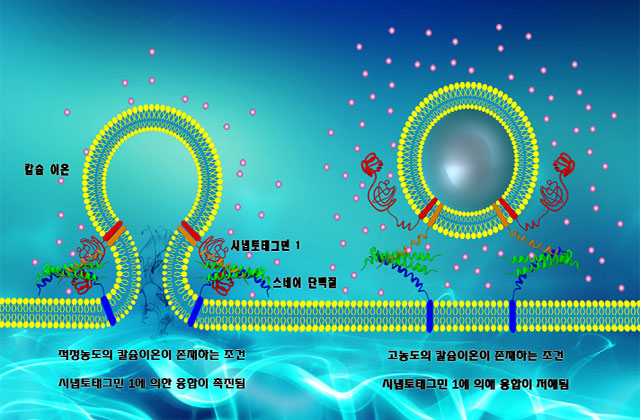Scientist Resolve Decade-long Puzzle of 'Protein Function'
Lee YouKyoung 2011-10-04 View. 17,453

Scientist Resolve Decade-long Puzzle of 'Protein Function'
The Ministry of Education, Science and Technology(Ahn Byung-man, Minister) said on May 7 that a research team led mostly by Korean researchers had identified for the first time that Synaptotagmin1, a plasma membrane protein, proactively regulates the communication processes of nerve cells.
Study published in world's top journal, Science
Synaptotagmin1 is one of two major proteins that regulate the excretion of neurotransmitters. Thus far, the research community has speculated that simple introduction of calcium ions leads Synaptotagmin1 to excrete neurotransmitters, but has failed to identify its exact functions.
In the study led by Prof. Yoon Tae-young of KAIST, the researchers identified that Synaptotagmin1 serves as a switch that freely regulates the intensity of communication between nerve cells.
The research team confirmed for the first time that the introduction of calcium ions at an appropriate density level(10umol/L) into nerve cells causes Synaptotagmin1 to swiftly excrete neurotransmitters, but that contrary to expectations, their introduction at above the appropriate density level decreases the function.
This indicates that Synaptotagmin1 responds in various fashions according to the density of calcium emitted from nerve cells. Thus, the scientists have newly discovered that Synaptotagmin1 can freely control the intensity of communication between nerve cells.
The new study has discovered for the first time that Synaptotagmin1 most robustly activates at a low calcium density level, and precisely explained the function of Synaptotagmin1, a puzzle that previous studies had failed to resolve.
The research team also identified that the detachment of Synaptotagmin1 from membranes leads to the loss of its regulatory switching function, thus discovering that the attachment and non-attachment of Synaptotagmin1 onto and from membrane comprise the centerpiece of its function.
Furthermore, Prof. Yoon's research team successfully developed a new technology that allows scientists to monitor the functions of membrane proteins, which are a major target in the quest to develop next-generation new drugs.
According to the ministry, membrane proteins play essential roles within the cell, including substance transport, and are closely related with diverse diseases, including cancer, diabetes, and obesity. Hence, they account for up to nearly 70% of the target proteins in the effort to develop new next-generation drugs.
The team successfully developed single-vesicle fluorescence detection, and thus secured internationally top-flight technology that allows them to monitor the function of membrane proteins at single-molecule or multi-molecule levels.
Prof. Yoon said, "The study has identified the function of Synaptotagmin1, which the academic community has failed to decipher over the past 10 years, and has developed a new technology that enables us to monitor the complicated functions of membrane proteins at the molecular level." Expounding on the significance of his research, he added, "The study has tapped the possibility to develop new drugs for diseases afflicting people of the modern world, including cancer, diabetes and obesity."
The study was conducted jointly by nine researchers, including Prof. Yoon, Dr. Lee Han-ki of POSTECH, Prof. Shin Yeon-kyun of Iowa State University, Prof. Kweon Dae-hyuk of Sungkyunkwan University, and Prof. Hyeon Chang-bong of the Korea Institute of Advanced Study. The study was published in the May 7 issue of Science, one of the world's top science journals.
[May 31, 2010]
- - - - - - -
Source - HelloDD.com

 Delete Article!
Delete Article!